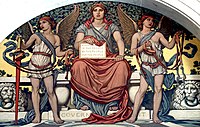
Photo from wikipedia
The exchange rate and international oil prices are the key variables that indicate the impact of external economic developments, agreements, and relationships. Since in countries like Iran, the government’s revenues… Click to show full abstract
The exchange rate and international oil prices are the key variables that indicate the impact of external economic developments, agreements, and relationships. Since in countries like Iran, the government’s revenues mostly come from oil exports in the international markets in the form of foreign exchange, the impact of two variables on the economy has a significant outcome, and fluctuation in both of variable can change the policy. Moreover, the impact of the oil price on the production of goods changes the supply level of economic sectors and incomes of institutions through changing the factors of production and value of intermediate imports. It is significant that the government budget one of the crucial resources to make the fundamental structure of policy to cover expenses. This research has been done using the Computable General Equilibrium (CGE) model in which all markets have settled simultaneously to explore the effects of exchange rate fluctuations and international oil prices on Iran's economy in different scenarios using the Social Accounting Matrix (SAM) of 2011. Results show that any increase in exchange rates and oil prices lead to an increase in government revenues from sales of production factors, and it is more sensitive about oil price shocks, as well as the government faces budget surpluses. Also, when the government faces a surplus or deficit, consumption, saving, and payments change as the model is optimal. Besides, it should be noted that for Iran, using the uniform direct tax policies is more optimal because the budget is less unstable.
Journal Title: iranian economic review
Year Published: 2020
Link to full text (if available)
Share on Social Media: Sign Up to like & get
recommendations!